3. Circular fashion
##Assignments must-haves
- Zero waste! Design on a grid if you want to do this. See Jessica Stanley's example.
- Make it modular: same module should enable the creation of many different garments
- Create a garment
- Take nice pictures
- Upload .dxf files
- add design to opencircularfashion website.
Personal must-haves
- Volume!
- Color!
- A big garment!
Cecilia's Tips and tricks
- There should be a logic to this to I guess. Write it up, document it REAAAAAAALLY well. Test your instructions with someone else.
- Make a "pattern", like a knitting pattern.
- To make a garment: design the modules into the dress pattern, you can design finished edges.
- Rhino can make nice arrays
- Grid: triangle, hexagon, square? This determines your structure.
- Use decorative elements: what do you want it to look like?
- Material: determines width of cuts and arrows.
Inspiration
Drag aesthetic
Here are two of my fav drag queens who featured on RuPaul: Kimchi (top) and Trixie Mattel (bottom), and Violet Chachki (bottom right), who is probably not my favourite, but this pink tassled ensembluh is pretty amazing.
What I love love love about kimchi is her fearless choice of geometric garments. I mean she goes big and chunky and pulls it off so well. I think she self-tailors almost all of it too. And the color palette with the pastels, especially the minty green with pink. It's a win.
Trixie on the other hand, way less avant-garde and instead more country-barbie on steroids just know her hot pinks and I love how she uses big shoulders and jackets for added curve and swerv. She makes ugly even uglier. Utmost respect. I'm all for the camp.
Technical inspiration
Increasing and increasing like knitting
This church I pass by everyday actually has a gorgeous pattern! The way it goes from small elements to bigger ones is also a way to increase and decrease in width. One of the things I'd like to do.
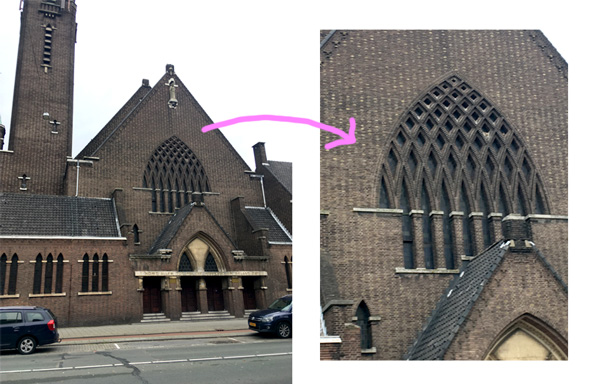
The church I pass by every day, Loes Bogers
Tesselation and interlocking inspiration
- See documentation of of Jessica stanley from last year: it's male/female AND zero waste.
- You can encode messages in the textile too! Eg. Jessica's binary.
- Rei Kabakubo-Comme des Garcons worn by Rihanna. OMG yes.
- Post-Couture Antwerp. Look at their double interlocks. It helps to make things really wearable. Like a tiewrap.
- Ernst Heinrich Häckel's biological drawings!
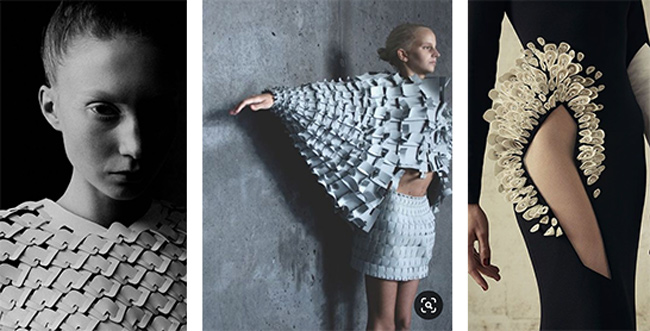 Other beauties by (left to right): Katie Roberts-Wood, Matija Cop and Stephane Rolland AW16 Haute Couture
Other beauties by (left to right): Katie Roberts-Wood, Matija Cop and Stephane Rolland AW16 Haute Couture
Personal preferences:
- Volume volume volume, I want big shapes
- zero waste all the way, using waste stream of lab
- semi-intuitive assembling and modeling on the body
- modules should enable fast improvising, module should give lots of options to play, like legos! But still have a nice look to it of course.
Personal dislikes
- net-like structures
- crazy tiny pieces (horror assembling)
- very thick structures that need a lot of material to cover a small area
Research
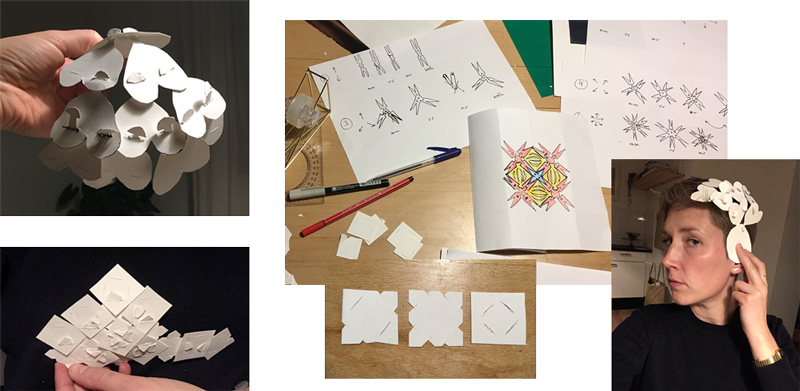 Lots of sketches and try-outs, Loes Bogers
Lots of sketches and try-outs, Loes Bogers
Sketching and paper prototyping
I tried out a bunch of things in paper and was immediately trying to make even the paper version go 3D, by finding options to increase width and decrease width, like you can do with crochet for example. Somewhat successful, definitely settled my ambition to go for volume. This phase was really necessary to wrap my head around the technique, and the paramaters to think about.
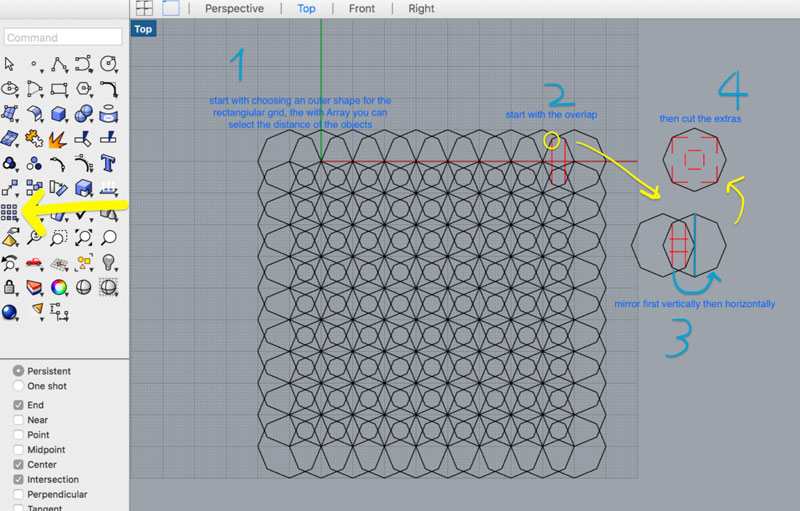
Me trying to wrap my head around directions, and Cecilia's explanation of making a module in Rhino :)
Test 1: keep it simple, explore materials
I designed a very simple module first to just understand what playing with assembling already gives me without making the design more complex. Start simple, expand:
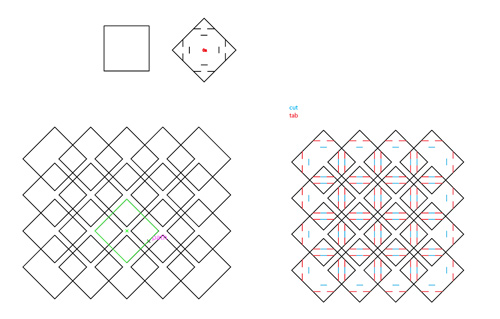
The first design: rectangles with both slots and tabs for each direction
Same module, different materials
I tested my basic square module with:
- denim - nice dark blue and light blue using inside and outside, frayed edges, hard to assemble!!! Lies flat.
- dense felt (white) - gave brown burn marks, I don't like that. Lies flat.
- loose felt (salmon) - looks nice, feel nice, really hard to assemble and easy to tear apart. Lies flat.
- fake leather (green) - keeps integrity very nicely! Lies very flat, few burn marks, nice clean cut, totally keeps its shape, falls heavy down the lines of the body. Can be very nice.
- organza (hot pink) - love the color, love the transparency effect. Hate how much it frays during handling. This is not for me at all. Also cutting at a diagonal didn't solve this. I dont' have a high pain threshold for fraying fabric.
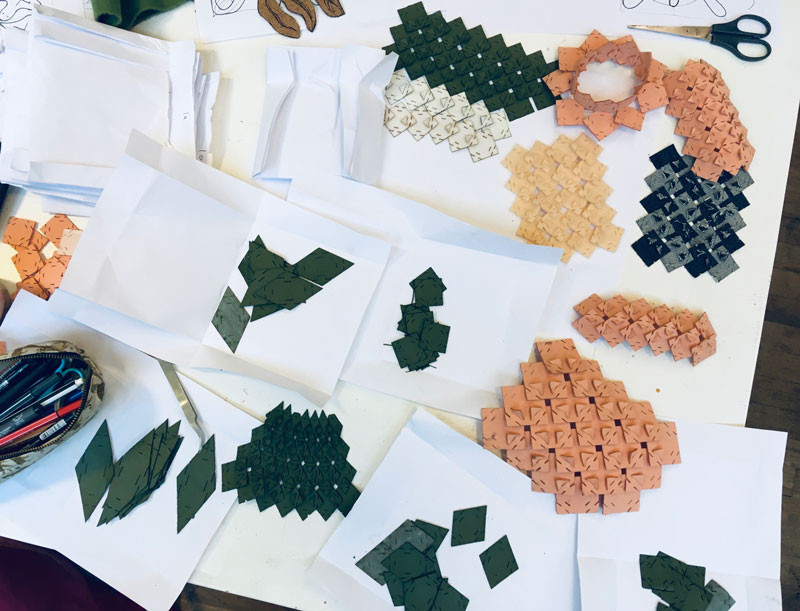
Playing and assembling with the same module cut from different materials, Loes Bogers
Oh a potential winner!
- the EVA foam - this is thermoformable hobby foam - a property that could be nice to explore later too - and it's alive! Even using plan rectangles it starts to curve a bit, and playing with directions, alternating between slotting the tabs in from the back or front already gives curves, and creates tubes shapes. Greaaaat!!!! It also feels very nice on the skin. It's a bit stinky to cut, and there's slight burning but I can try reduce it with the settings. The tabs do change shape a little when manipulating it, but it also adds a nice irregularity to the computational vibe I guess? I can live with it. It can stand some diffuse strain, but not tearing at one point.
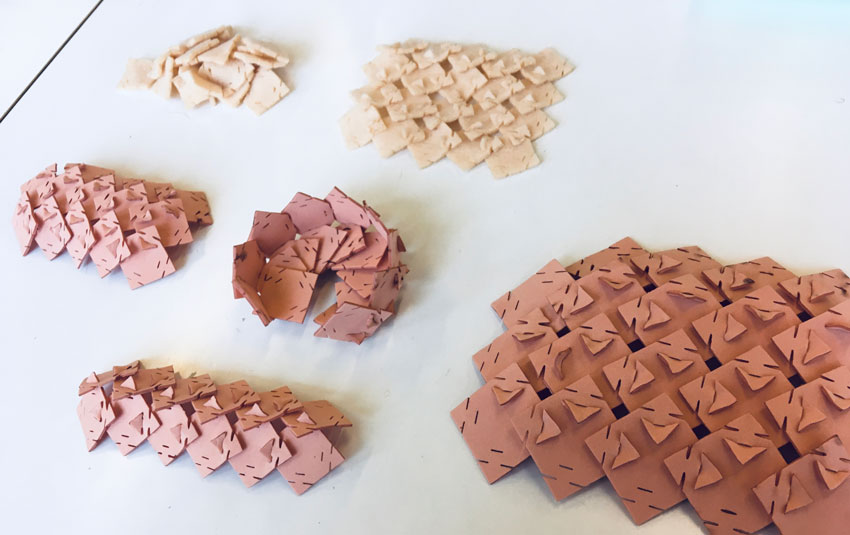
Testing with EVA foam and loose felt, Loes Bogers
Test 2: Increasing and decreasing
For the second tests I wanted to continue with the fake leather and foam and try to make modules that I can use to increase and decrease to make nice shapes around the body. I took the church as inspiration but went for a somewhat simpler diamond shape.
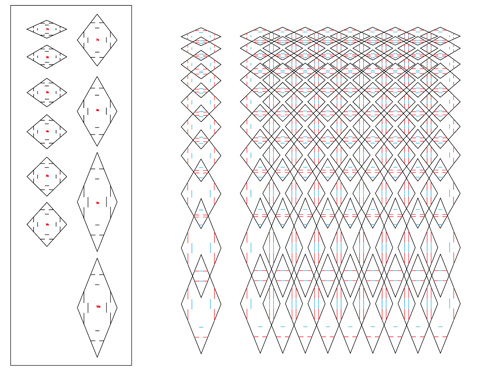
The second design, increasing in height, Loes Bogers
I started with only one manipulation: by only increasing the size of the module on one axis and keeping the other the same. I cut it and just started playing with it. I thought changing both the x AND Y axes could be the next step. But then a happy accident happened...
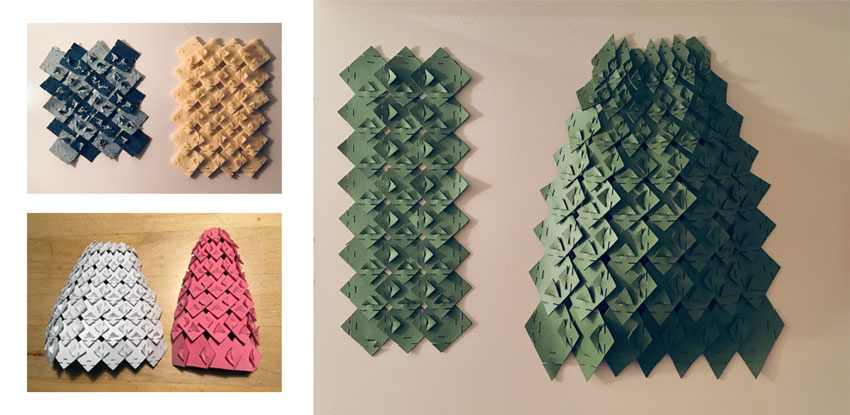
Swatches: (clockwise) denim outside and inside of cloth, loose felt, fake leather, EVA foam (white and pink). The white, pink and green swatch are cut in the second iteration of the design, you can see how they start curving. Loes Bogers
That step never came! I unintentionally started rotating the pieces, thereby accidentally creating increase on the x-axis AND the y-axis, which magically worked out really well!
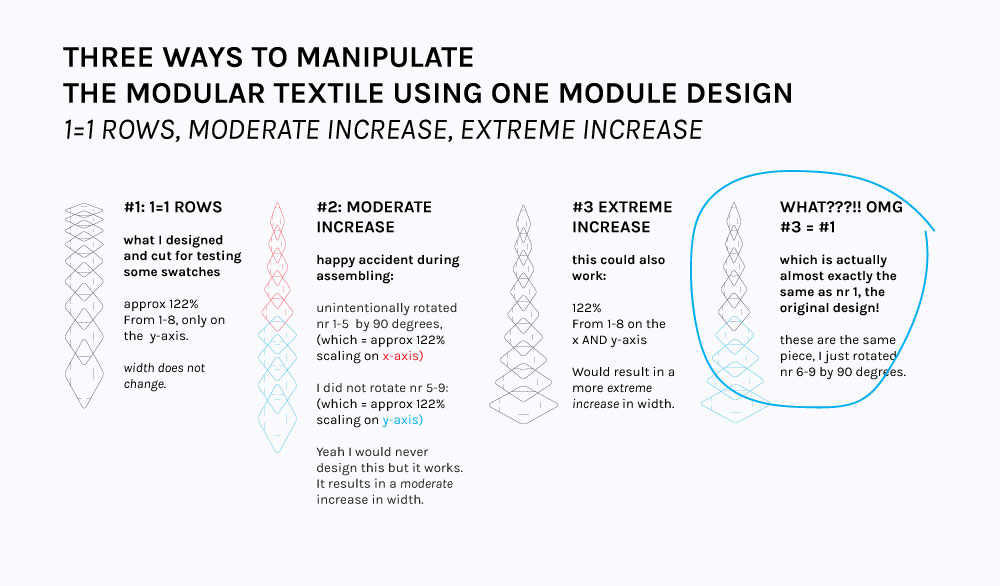 Explanation of what happened and how it accidentally has some kind of mathematical logic to it...???
Explanation of what happened and how it accidentally has some kind of mathematical logic to it...???
Laser tricks
- pieces flying away? Turn the screw of the laser head to reduce the airflow from the blower in the laser head (at my lab at work). Perfection, no fire. Do not try this without consulting your lab manager
- pieces flying away? Put a piece of cardboard under your material, spray it generously with water, and stick you fabric on (temporarily).
- Don't use speed 400 for small designs, it never catches up to speed so you're using pseudo settings. Test cut with a module, not a 10mmx10mm square.
Design tricks
- Path finder > Outline to take out double lines (save yourself laser time!)
- Great way to make arrays that transform along the way (scaling and moving): in the menu bar: Effect - Distort & Transform - Transform tool. Also see this tutorial, by Project Lady (amazinggggg name btw) for further instructions on adding organic-looking warps after. Did not get to it for now but would be very interesting to play with.

